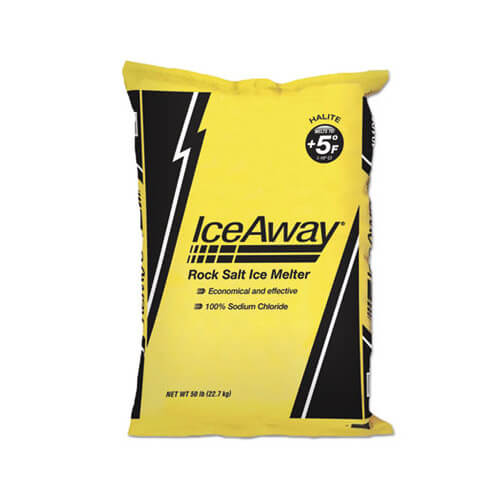
Rock Salt (De-icing Salt)
Rock salt is the most common deicing product used for roads, sidewalks, and driveways. Rock salt is relatively inexpensive and does a good job of reducing ice build-up. The drawbacks of using rock salt are the high levels of dirt that are included with the salt, and effective temperature is only 5 degrees Fahrenheit.
- Product: Ice Away Rock Salt
- Weight: 50 LB
- Effectiveness: Temperatures as low as 5°F
- Availability: In-Stock
Schedule Delivery
Extraction Process and Salt Mining
Rock salt is mined from underground deposits by drilling and blasting. Deposits are reached through a circular shaft, typically about 20 feet in diameter and as deep as 2,000 feet, depending on the depth and location of the salt deposit.
Shafts are lined with concrete, at least through the overburden and into the top of the salt deposit, and often all the way to the shaft bottom.
Mining methods depend on whether the salt is configured as a relatively horizontal sedimentary deposit or a more vertical salt dome. The differences in mining methods depend on the thickness and structure of the salt deposit. Bedded or layered deposits are mined using the room and pillar mining method, as horizontal rooms or entries of about 10-25 feet high and 50 feet wide. Openings or cross-cuts are created perpendicular to the length of the rooms to connect the rooms at planned intervals. Salt pillars are left in place to provide structural support for the overlying roof and other layers. Most room-and-pillar mines recover about 45-65% of the salt available, with the remainder left behind as pillar supports with margins both above and below the mined area. Each day, based on production needs, several rooms are blasted, each blast bringing down 350-900 tons.
In salt domes, after a level of room-and-pillar extraction is completed, the usual practice is to “bench” the mine by drilling and blasting the floor extending the excavation downward and removing vast quantities with each blast.
Typically salt is mined using large, diesel-powered equipment designed for undercutting, drilling, blasting, loading and transporting the blasted salt.
Diesel-powered trucks take the salt freed by blasting to a system of crushers and conveyor belts, and ultimately, to the hoist or “skip.” Sometimes the salt is stockpiled in the mine where it awaits hoisting; other operations maintain surface storage stockpiles. Each skip can lift 18-20 tons of salt, and they move quickly. A large mine may be able to hoist up to 900 tons an hour.
Rock Salt for Water Softening
While rock salt can be used for water softening, we don't recommend it due to its high amount of calcium sulfate and impurities that won't dissolve well in water. This means it will most likely mean more tank cleaning and more maintenance need for your water treatment system.
Consider using solar salt, pellet salt or mini cube salt for your water softener. It will keep your unit running more efficiently with less maintenance.
Rock Salt Delivery in the Twin Cities
Does your home or business need de-icing salt for sidewalks, parking lots, driveways, or roadways? Robert B. Hill Co has been delivering tock salt to Twin Cities businesses for over 60 years. Contact us today to get a quote and scheduled for salt delivery. You can also come and pick up salt at our St. Louis Park office.
Contact Us
